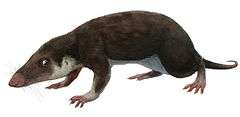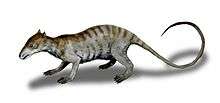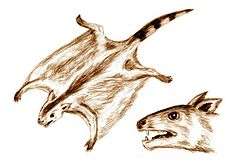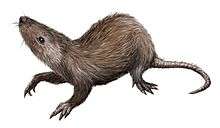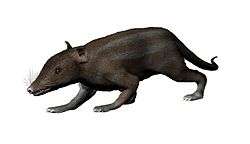Sudamericidae
Sudamericidae is a family of gondwanathere mammals that lived during the late Cretaceous to Miocene. Its members include Lavanify and Vintana from the Cretaceous of Madagascar, Bharattherium (=Dakshina) from the Cretaceous of India, Gondwanatherium from the Cretaceous of Argentina, Sudamerica from the Paleocene of Argentina, and unnamed forms from the Eocene of Antarctica (closely related to Sudamerica) and Cretaceous of Tanzania.[2] More recently, Patagonia, a mammal from the Colhuehuapian stage of the Miocene of southern South America, has been suggested to be a sudamericid.[1]
| Sudamericidae | |
|---|---|
| Scientific classification | |
| Kingdom: | Animalia |
| Phylum: | Chordata |
| Clade: | Therapsida |
| Clade: | Cynodontia |
| Clade: | †Gondwanatheria |
| Family: | †Sudamericidae Scillato-Yané & Pascual, 1984 |
| Genera | |
| |
| Synonyms | |
| |
Vintana is one of the most complete gondwanathere remains, and offers an insight to the anatomy and habits of sudamericids as a whole. It possesses massive lateral flanges in its skull, and bears massive olfactory bulbs. At 20 pounds (9.1 kg), it is one of the largest Mesozoic mammals known.
References
- Nicolás R. Chimento, Federico L. Agnolin and Fernando E. Novas (2015). "The bizarre 'metatherians' Groeberia and Patagonia, late surviving members of gondwanatherian mammals". Historical Biology: An International Journal of Paleobiology. 27 (5): 603–623. doi:10.1080/08912963.2014.903945.CS1 maint: uses authors parameter (link)
- Gurovich and Beck, 2009; Krause et al., 1997; Prasad, 2008; Prasad et al., 2007; Wilson et al., 2007
Literature cited


- Prasad, G.V.R. 2008. Sedimentary basins & fossil records. Pp. 90–96 in Singhvi, A.K. and Bhattacharya, A. (eds.). Glimpses of Geoscience Research in India: The Indian Report to IUGS 2004–2008. New Delhi: The Indian National Science Academy (INSA).
- Prasad, G.V.R., Verma, O., Sahni, A., Krause, D.W., Khosla, A. and Parmar, V. 2007. A new late Cretaceous gondwanatherian mammal from central India. Proceedings of the Indian National Science Academy 73(1):17–24.

